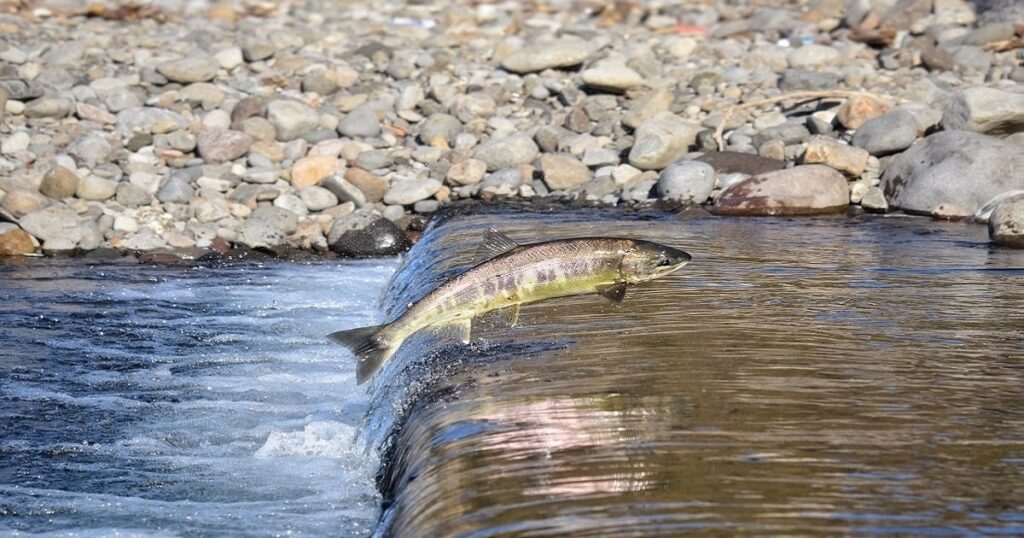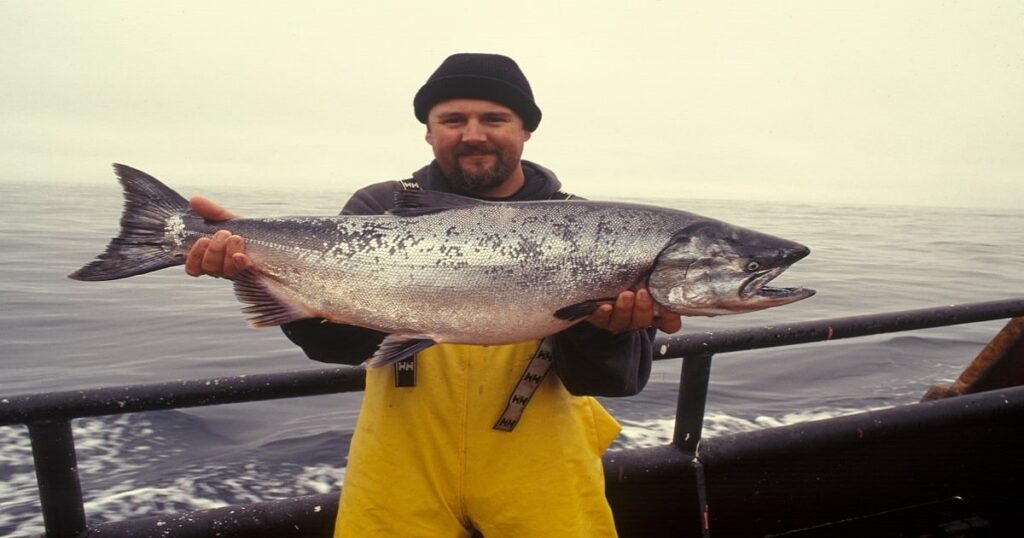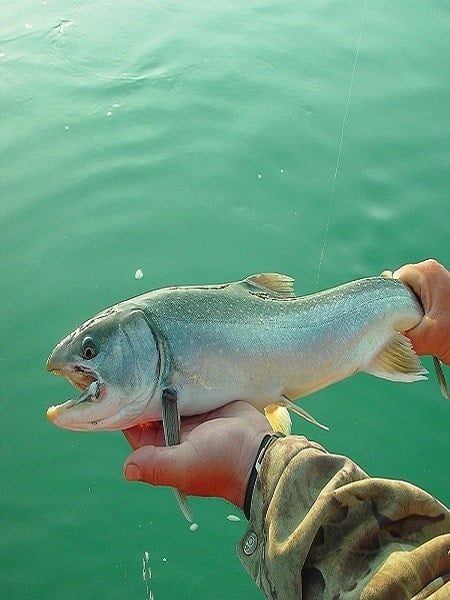Salmon are a popular and highly sought-after species by both recreational and commercial fishermen worldwide. There are several species of salmon, each with its own unique characteristics and distribution. Here are the main types of salmon:
- Atlantic salmon (Salmo salar): Found in the Atlantic Ocean and its tributaries, including rivers in North America and Europe.
- Chinook salmon (Oncorhynchus tshawytscha): Also known as king salmon, this species is found in the North Pacific Ocean and its tributaries, including rivers in North America and Asia.
- Coho salmon (Oncorhynchus kisutch): Also known as silver salmon, this species is found in the North Pacific Ocean and its tributaries, including rivers in North America and Asia.
- Sockeye salmon (Oncorhynchus nerka): Also known as red salmon, this species is found in the North Pacific Ocean and its tributaries, including rivers in North America and Asia.
- Pink salmon (Oncorhynchus gorbuscha): Also known as humpback salmon, this species is found in the North Pacific Ocean and its tributaries, including rivers in North America and Asia.
Habitat
Salmon are a type of anadromous fish, meaning that they are born in freshwater, migrate to the ocean, and then return to freshwater to spawn. They can be found in both the Atlantic and Pacific oceans, as well as in several large river systems worldwide.
In the Pacific, salmon are found from California all the way up to Alaska. They prefer cool, clean water with a high oxygen content and a gravel bottom for spawning. In the Atlantic, they are found in the rivers that empty into the ocean, such as the Gulf of Maine, the Bay of Fundy, and the Miramichi River.
Feeding Habits
Salmon are predatory fish that feed on a variety of aquatic organisms. Their feeding habits can vary depending on their life stage and the specific species of salmon. Young salmon, known as fry, primarily feed on small aquatic insects and other invertebrates then as they grow transition to feeding on larger prey such as small fish, crustaceans, and mollusks.
Adult salmon that are preparing to spawn may stop feeding altogether, relying on stored energy reserves to make their journey upstream. In the ocean, adult salmon feed on a variety of prey including krill, shrimp, squid, herring, and other small fish.
Some species of salmon, such as Chinook salmon, are known for their particularly voracious appetites and may consume up to 5% of their body weight in a single day.

Size and Lifespan
The size of salmon varies depending on the species. The smallest species of salmon is the pink salmon, which averages around 4-6 pounds. The largest species is the Chinook salmon, which can weigh up to 100 pounds. Other species such as coho, chum, and sockeye salmon usually weigh between 6-20 pounds.
The lifespan of salmon fish again varies depending on the species. For example, pink salmon generally live for two years, while sockeye salmon can live up to six years. Chinook salmon, also known as king salmon, can live up to seven years, while Atlantic salmon can live up to eight years.
Salmon Fishing Records
Salmon fishing records can vary depending on the specific type of salmon, the location of the catch, and the fishing method used. Here are some examples of notable salmon fishing records:
- Largest Atlantic Salmon: The largest Atlantic salmon ever caught weighed 97 pounds and was caught in the Alta River in Norway in 1928.
- Largest Chinook Salmon: The largest Chinook salmon ever caught weighed 97 pounds and was caught in the Kenai River in Alaska in 1985.
- Largest Coho Salmon: The largest Coho salmon ever caught weighed 33 pounds and was caught in Lake Ontario in 2010.
- Largest Sockeye Salmon: The largest Sockeye salmon ever caught weighed 16 pounds and was caught in the Kenai River in Alaska in 1974.
- Largest Pink Salmon: The largest Pink salmon ever caught weighed 15 pounds and was caught in the Big Salmon River in Canada in 2015.
It’s worth noting that fishing records are often contested, and there may be discrepancies between different sources. Additionally, there may be larger fish that were caught but not officially recorded.

How to identify a Salmon
Here are some key characteristics to help you identify a salmon:
- Shape: Salmon have a streamlined, torpedo-shaped body that is designed for swimming quickly through the water.
- Colour: Depending on the species, salmon can range in colour from silver to blue-grey to greenish-brown on their back with a lighter coloured underside. They may also have spots on their back, tail and fins.
- Scales: Salmon have small, overlapping scales that are easily visible on their skin.
- Fins: Salmon have several fins including a dorsal fin (on their back), an adipose fin (small fleshy fin behind the dorsal fin), pectoral fins (located on the sides of the body), pelvic fins (located on the underside of the body), and an anal fin (located on the underside of the body near the tail).
- Behaviour: Salmon are known for their ability to swim upstream to spawn in freshwater rivers and streams. During this time, they may exhibit a variety of behaviours such as jumping out of the water, swimming near the surface, and moving in large groups.
Overall, if you see a fish with a streamlined body, small scales, multiple fins, and a coloration that ranges from silver to brown with spots, it’s likely to be a salmon.
How to catch a Salmon
Catching salmon can be a thrilling and rewarding experience, but it does require some skill and knowledge. Here are some tips for catching salmon with fishing tackle and bait:
- Choose the Right Tackle: The type of fishing tackle you use will depend on the species of salmon you are targeting and the location you are fishing in. For example, if you are fishing in a river, you may want to use a spinning rod and reel, while if you are fishing in the ocean, you may want to use a downrigger or a trolling rod and reel.
- Use the Right Bait: Salmon are known to be attracted to a wide range of baits, including shrimp, squid, herring, and anchovy. You can use live or dead bait, or even artificial lures that mimic the movement of these baits.
- Understand the Migration Patterns: Knowing the migration patterns of salmon can help you determine the best time and location to fish for them. For example, in the Pacific Northwest, salmon typically migrate upstream to spawn in the fall, making it an ideal time to fish for them.
- Practice Patience: Catching salmon can be a waiting game, so be prepared to spend some time on the water. You may need to try several different spots or change your bait to attract the fish.
Salmon fish are a popular and highly valued species that require skill and knowledge to catch. Understanding their habitat, lifespan, size, feeding habits, and how to catch them with fishing tackle and bait can help you have a successful and enjoyable fishing experience.
